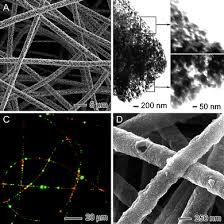Preparation of polystyrene nanofiber modified with Dithizone using electrospinning technique
Keywords:
Nanofiber; Polystyrene; Electrospinning; DithizoneAbstract
In this paper, polystyrene nanofiber were made using electrospinning polystyrene inside THF/DMF solvent. The major parameters such as voltage, distance between injection and collector, polystyrene concentration and rotating speed of collector were optimized in electrospinning technique. The results indicated that in specific range, with increasing voltage, high electrospinning distance, low flow of injection and high collector’s speed, we could achieve to nanofiber having regular chain structure and less diameter. In optimal condition and unmodified surface, polystyrene fiber had average diameter of 82.1 nm. Finally polystyrene absorbent by dithizone were modified and through selecting best condition, the modified polystyrene nanofiber with 92.98 nm average diameter were obtained which although it has more diameter than unmodified nanofiber, it possesses properties which the unmodified nanofiber does not have those properties, for example property of absorbing metals.
References
Anwar, M.M., 2015. Influence of Nano materials on flexural behavior and compressive strength of concrete. HBRC Journal., paper in press.
Ulrich, A.M., Dahoun, B., G'Sell, A., 1993. Spherulitic morphology of isotactic polypropylene investigated by scanning electron microscopy. Polymer., 34, 4817-4825.
Baumgarten, P.K., 1971. Electrostatic Spinning of Acrylic Microfibers. J. Colloid Interface Sci., 36, 71-79.
Nanotechnology Task Force. Berlin: Federal Institute for Materials Research and Testing, 2011. Taken from ISO/TS 27687:2008 Nanotechnologies - Terminology and definitions for nano-objects - Nanoparticle, nanofibre and nanoplate.
Zhou, F.L., Gong, R.H., 2008. Manufacturing technologies of polymeric nanofibres and nanofibre yarns. Polymer International., 57, 837–845.
Benicewicz, B.C., Hopper, P.K., 1991. Polymers for absorbable surgical sutures. J. Bioact. Compat. Polym., 6, 64-94.
Yao, C., Li, X., Song, T., 2007. Fabrication of zein/hyaluronic acid fibrous membranes by electrospinning. J Biomater Sci Polym Ed., 18, 731-742.
Chen, Z., Mo, X., Qing, F., 2007. Electrospinning of collagen-chitosan complex. Materials Letters., 61, 3490–3494.
Um, I.C., Fang, D., Hsiao, B.S., Okamoto, A., Chu, B., 2004. Electro-spinning and electro-blowing of hyaluronic acid. Biomacromolecules., 5, 1428–1436.
Wang, L.S., Hong, R.Y., 2001. Synthesis, Surface Modification and Characterisation of Nanoparticles. DOI: 10.5772/10540. 289-322.
Woznica, E., Wójcik, M.M., Wojciechowski, M., Mieczkowski, J., Bulska, E., Maksymiuk, K., Michalska, A., 2012. Dithizone Modified Gold Nanoparticles Films for Potentiometric Sensing. Anal. Chem., 84, 4437–4442.
Billman, J.H., Cleland, E.S., 1955. Dithizone. Org. Synth Coll., 3: 360.

Downloads
Published
How to Cite
Issue
Section
License
Copyright (c) 2020 Majid Saghi, Davood Kaviani, M. Hajipoor, B. Assadi, M.H. Bigtan

This work is licensed under a Creative Commons Attribution-NonCommercial-NoDerivatives 4.0 International License.



